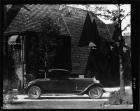|
Re: Best trany oil for 1929 Packard 8?
|
||||
|---|---|---|---|---|
|
Home away from home
|
Greg, 90 weight GL-1 available at any NAPA store.
Posted on: 4/7 14:04
|
|||
|
||||
|
Re: Drive shaft lubricant
|
||||
|---|---|---|---|---|
|
Home away from home
|
John, am sure PGH's grease fine, but we've done well with black molybdenum/graphite grease.
Posted on: 4/5 13:42
|
|||
|
||||
|
Re: assembly diagram for 1949 356 CID carburetor?
|
||||
|---|---|---|---|---|
|
Home away from home
|
Tristar, like all 1942-on 356 engines, your '49 Custom uses a Carter WDO 531-S(A).
Here's a copy of a copy, and the print is small, should the attached help.
Posted on: 3/28 17:01
|
|||
|
||||
|
Re: Best alignment specs for 1946-47 Super/Custom Super?
|
||||
|---|---|---|---|---|
|
Home away from home
|
PGH, your differential gets GL-5, EP (extreme pressure) which is for hypoid gears. Your manual transmission, overdrive, and steering gear are not hypoid, get GL-1. There've been entire threads on these forums detailing that.
My question was if there might be something better than GL-1 90 for our Gemmer steering boxes in 2025. If not, it's GL-1 90.
Posted on: 3/26 13:42
|
|||
|
||||
|
Re: Best alignment specs for 1946-47 Super/Custom Super?
|
||||
|---|---|---|---|---|
|
Home away from home
|
Thanks, Bwana. The '47 owner's manual says "straight mineral gear oil" for the steering gear, the 1946-1950 Packard Shop Manual "SAE 90 gear oil." But wondered if there were any improvements in this day and age. GL-1 90W it is, then.
Posted on: 3/26 0:47
|
|||
|
||||
|
Re: Best alignment specs for 1946-47 Super/Custom Super?
|
||||
|---|---|---|---|---|
|
Home away from home
|
Thank you, PGH, TXG, BigKev, all. For what it's worth, the 60-year-old alignment shop owner/operator, who's done not just GM-type i.f.s. as in 1941-on Clippers, but Safe-T-Flex also, suggests using STP, the original goop, in the steering box. I'm no fan of mouse milks, the only vetted use for STP i know being my late ex-War II Pacific motor pool staff sergeant, Packard service dept. 1946-47, then Hudson, GM dealerships mechanic, who before starting his own shop in 1959, specializing in transmissions -- rebuilt an Ultramatic for me decades ago with no more effort than an old HydraMatic, Borg-Warner, Dynaflow, TorqueFlite, et al -- used a mix of 50/50 STP/AFT as assembly lube.
However, saw this exchange on H.A.M.B. Jalopy Journal, thereon being many experienced souls, Packardites among them: "Was talking to a buddy last night and he mentioned he has always used straight STP in his steering boxes as a lubricant. I wasn't aware it could be used for that. I'm curious to know if anybody has/is using it? No! STP is not really a lubricant, it is a heavy dose of viscosity index improvers (long chain polymers, plastic) in a simple base oil. I wouldn't use that crap in anything, let alone use it as the sole lubricant in a steering box. This is one of those things where you just have to let people tell what they do, smile, and walk away." So, sports fans, what's best for our Packard Gemmer steering boxes? Can you gents make this loony traffic go away? Argh. As Morgan owner Jean Shepherd closed his WOR broadcasts, "It never ends, folks. It never e n d s."
Posted on: 3/25 14:59
|
|||
|
||||
|
Re: Best alignment specs for 1946-47 Super/Custom Super?
|
||||
|---|---|---|---|---|
|
Home away from home
|
Meanwhile, the 1940-1953 Chilton's Auto Repair Manual lists caster "1 1/2 degrees positive to 2 1/2 degrees positive," against the 1946-1950 Packard Shop Manual's "negative 2 degrees plus or minus half a degree." Why such a discrepancy? Were there reports from the field by the early '50s?
1940-1953 Chilton's gives 1/4 degree negative to 3/4 degree positive camber, the 1946-1950 Packard Shop Manual 0 plus or minus 1/2 degree. Chilton's toe-in 0 inches, 1946-50 Packard Shop Manual 0 plus 1/16th of an inch, minus 0. So not much variance there. Then why the gulf in caster?
Posted on: 3/25 1:22
|
|||
|
||||
|
Re: Best alignment specs for 1946-47 Super/Custom Super?
|
||||
|---|---|---|---|---|
|
Home away from home
|
BdeB, somehow i missed page 30 in the front suspension chapter of the brown 1946-50 Packard Shop Manual. Right y'are, thanks. TXG renders some thoughtful theory. I'm running, again, bias-sized radials of the same 7.00 x 15 my car left the factory on when i was earlier running bias tires.
So, unless i hear from someone with a 1942-47 160/180, Super/Custom Super Clipper running Yokohama, Bridgestone, Michelin, etc. bias-sized 7.00 x 15 radials, guess -- and that's the word -- g u e s s i'll split the difference in the 1946-50 Packard Shop Manual.
Posted on: 3/22 22:40
|
|||
|
||||
|
No, for the 86th time, Gen. MacArthur did not have a Clipper staff car
|
||||
|---|---|---|---|---|
|
Home away from home
|
Noting one of today's Photo of the Day, this was thoroughly debunked in the late, great, much missed Special Interest Autos and elsewhere back in the late '70s. It seems a new, equally gullible generation has joined those losing their minds/memories or thinking so-and-so having ridden in a car like theirs makes it better or worth more.
Abetted by down home museum displays of olive drabbed, blacked out Clippers--some of them postwar models at that -- and the internet, a new generation of buffs, or a forgetful older one, believe MacArthur had a '42 Packard Clipper staff car. If not riding in a Jeep, MacArthur was occasionally chauffeured in a '42 Cadillac Series 75 limousine belonging to the owner of a Philippine sugar plantation. Ike, Bradley and some other high brass in Europe did get '42 One-Sixty Clippers.
Posted on: 3/21 19:31
|
|||
|
||||

 Scan0006.pdf
Scan0006.pdf






